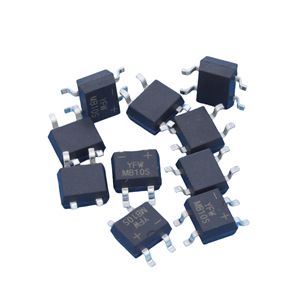Date:2024-09-20 Categories:Product knowledge Hits:433 From: Guangdong Youfeng Microelectronics Co., Ltd(YFW)
Field Effect Transistor (FET), abbreviated as FET, is a relatively new type of semiconductor material that uses the electric field effect to control the current of the transistor, hence its name. It is a semiconductor device that uses only one type of carrier to participate in conduction, which is a semiconductor device that controls the output current with input voltage. Divided by the carriers involved in conduction, it has N-channel devices with electrons as carriers and P-channel devices with holes as carriers. From the structure of field-effect transistors, they can be divided into junction field-effect transistors and insulated gate field-effect transistors.
1. Junction field-effect transistor
(1) Structure of junction field-effect transistor
It involves manufacturing PN junctions on both sides of an N-type semiconductor silicon wafer, forming a structure with two PN junctions sandwiching an N-type channel. The two P regions are the gate, and one end of the N-type silicon is the drain and the other end is the source.
(2) Working principle of junction field-effect transistor
Using N-channel as an example to illustrate its working principle.
When VGS=0, when a certain voltage is applied between the drain and source, multi carrier drift motion will be formed between the drain and source, resulting in drain current. When VGS is zero, the PN junction is reverse biased, forming a depletion layer. The channel between the drain and source will narrow, and the ID will decrease. VGS continues to decrease, the channel continues to narrow, and the ID continues to decrease until it reaches zero. The gate source voltage VGS corresponding to zero drain current is called the pinch off voltage VGS (off).
(3) Characteristic curve of junction field-effect transistor
There are two characteristic curves for junction field-effect transistors,
One is the output characteristic curve (ID=f (VDS) | VGS=constant),
The second is the transfer characteristic curve (ID=f (VGS) | VDS=constant).
Characteristic curve of N-channel junction field-effect transistor
2. Working principle of insulated gate field-effect transistor
Insulated gate field-effect transistors are divided into:
Depleted type → N-channel, P-channel
Enhanced → N-channel, P-channel
(1) N-channel depletion type insulated gate field-effect transistor structure
It is doped with a large amount of metal cations in the SiO2 insulation layer below the gate. So when VGS=0, these positive ions have already induced an inversion layer, forming a channel. So, as long as there is a drain source voltage, there is a drain current present. When VGS>0, it will further increase the ID. When VGS is 0, as VGS decreases, the drain current gradually decreases until ID=0. The VGS corresponding to ID=0 is called the pinch off voltage, represented by the symbol VGS (off), sometimes also represented by VP.
(2) N-channel enhanced insulated gate field-effect transistor structure
N-channel enhanced insulated gate field-effect transistor, with a structure similar to depletion type. But when VGS=0V, applying a voltage between D and S will not form a current between D and S. When a voltage is applied to the gate, if VGS>VGS (th), a channel is formed to communicate the drain and source. If a drain source voltage is applied at this time, a drain current ID can be formed. When VGS=0V and ID=0, drain current will only appear when VGS>VGS (th). This type of MOS transistor is called an enhanced MOS transistor.
VGS (th) - opening voltage or valve voltage;
(3) P-channel enhanced and depletion MOSFETs
The working principle of P-channel MOSFET is exactly the same as that of N-channel MOSFET, except that the conductive carriers are different and the polarity of the supply voltage is different. This is similar to how bipolar transistors have NPN and PNP types

Previous: Classification, Structure, and Principle of MOSFET
Next: How to determine the actual parameters of a transistor amplifier circuit?